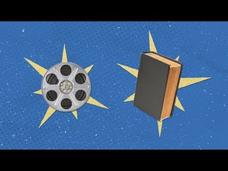PBS
A Farewell to Arms: Shaping Fact for Fiction
Clips from the documentary Hemingway by Ken Burns and Lynn Novick reveal how Ernest Hemingway incorporated his own war experiences in A Farewell to Arms. Young writers then take an experience from their own lives and craft it...
PBS
Hemingway’s Influences and Contemporaries
Three clips from the documentary Hemingway by Ken Burns and Lynn Novick explore the events and people who influenced Ernest Hemingway.
PBS
Exploring Hemingway’s Style
The man, the myth, and the reality. Three clips from the documentary Hemingway by Ken Burns and Lynn Novick introduce viewers to the unique features of Ernest Hemingway's writing style and the events in Hemingway's life that...
PBS
When the Book is Better than the Movie
Sometimes the book is better than the movie; other times, the movie comes out on top. A video discusses the topic of novels and their film adaptations, pointing out specific texts and how the tale translated to the big screen. The...
Other
Story Corps: Sound Portraits
Listen to the stories of neglected Americans in these audio profiles of people just trying to survive. Not only are their stories documented on the radio or on the web, but they also serve as a learning tool in classrooms across the...
Sophia Learning
Sophia: Determining Your Audience
A series of four screencasts explaining the importance of audience. Students learn the difference between the real audience and the audience the writer intends, how to create a specific audience instead of a general audience, how the...
Sophia Learning
Sophia: General and Specific Audiences
This video lesson focuses on analyzing your audience and tailoring your writing to it. It discusses the 4 types of audiences: real, intended, general, and specific; it explains how to choose writing styles such as tone, vocabulary, and...
Sophia Learning
Sophia: The Impact of Imagery
This lesson focuses on the impact of imagery in writing by adding "umph" to the text and engaging the audiences' five senses. It uses an example of a passage from "Wuthering Heights" and then the same passage with most of the imagery...
Sophia Learning
Sophia: Anticipating and Responding to Readers' Questions
This tutorial focuses on audiences and anticipating and responding to their questions using 2 videos. The first video focuses on determining, defining, and discussing real, intended, general, and specific audiences and also audience...
Sophia Learning
Sophia: Analyze the Impact of the Point of View
Notes describing a three-step process to analyze the impact of the point of view on a literary text. Notes can be both read and listened to.
Sophia Learning
Sophia: Audience and Writing Style
A screencast lesson defining different types of audience, discussing the importance of determining an audience, and explaining how a writing style should be chosen based on the needs and expectations of the intended audience.[5:18]...
PBS
Pbs Learning Media: Literary Elements and Techniques: Conflict
Learn how to identify different types of conflict in literature in this animated video [2:46] from WNET.
Sophia Learning
Sophia: Narratives
This tutorial uses text and audio to introduce narrative writing. [2:03]
eSpark Learning
E Spark Learning: Comparing and Contrasting Points of View Framing Video
By the end of this "quest", you will be able to compare and contrast different points of view in a text by reading "Gulliver's Travels" and telling the story from a different point of view. [1:10]












